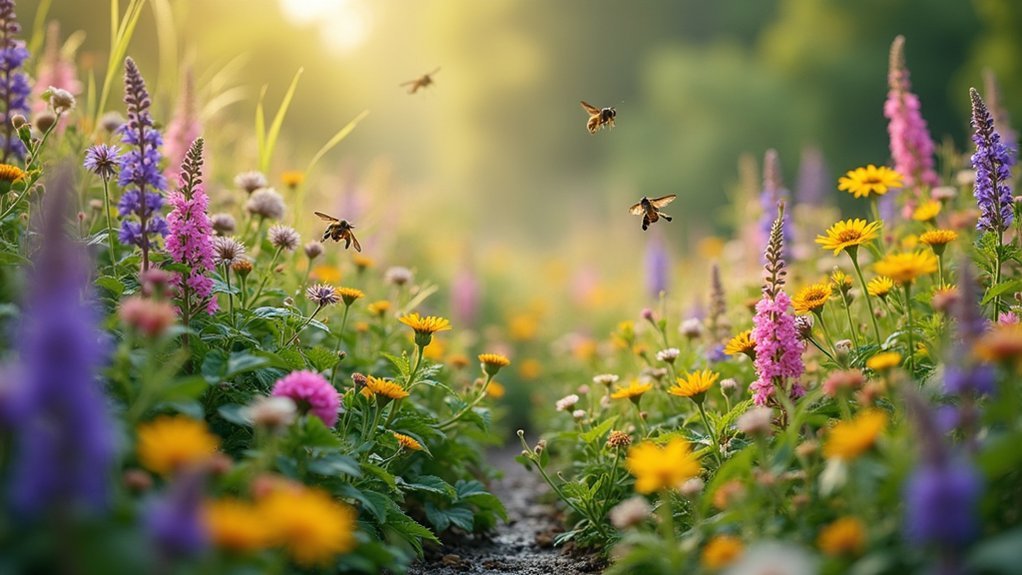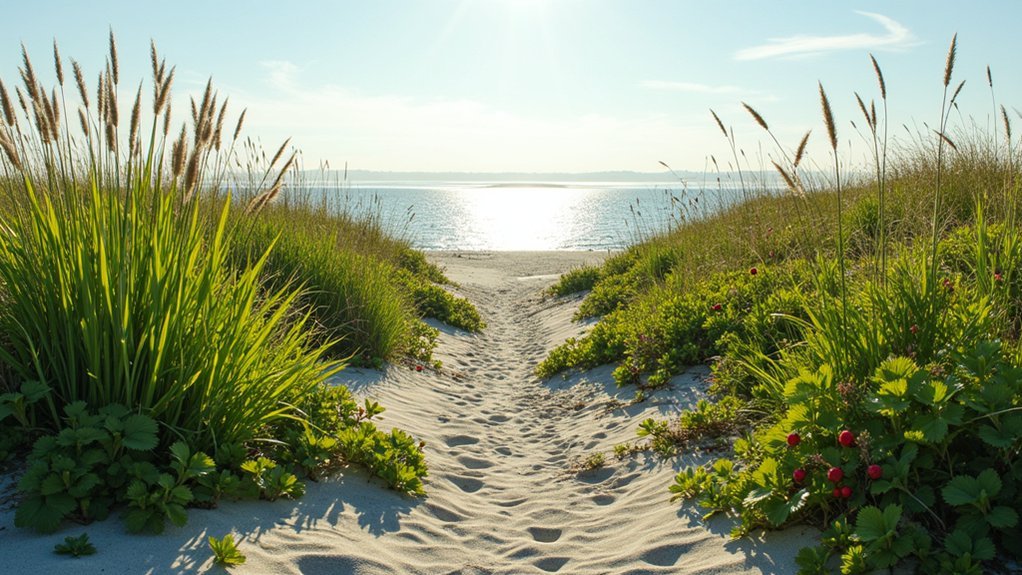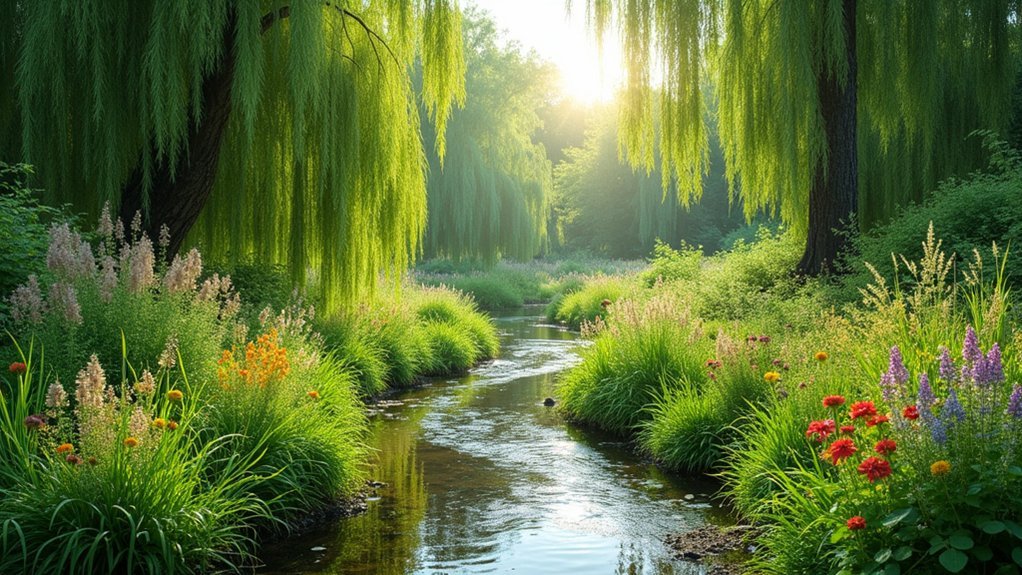The best plants for riparian buffer zones include Black Willow and River Birch for rapid bank stabilization, Swamp White Oak for wildlife habitat, and Silver Maple for flood control. For shrubs, choose American Elderberry and Red-osier Dogwood. Add deep-rooted grasses like Big Bluestem and Switchgrass, plus sedges for water filtration. You’ll create erosion protection while supporting local biodiversity. Explore how these native species work together to form effective waterway protection systems.
Native Trees for Bank Stabilization and Erosion Control

When selecting plants for riparian buffer zones, native trees should be your top priority for preventing streambank erosion. Black Willow’s extensive root systems excel at holding soil in place along waterways, making it an outstanding choice for erosion control.
Native trees are nature’s engineers, with species like Black Willow deploying root networks that secure vulnerable streambanks against erosion forces.
You’ll find River Birch establishes quickly, providing immediate bank reinforcement while supporting local bird populations.
For long-term stability, consider Swamp White Oak, which not only secures banks but produces acorns that sustain wildlife.
American Sycamore offers dual benefits with its cooling shade for aquatic ecosystems and deep, fibrous roots that anchor soil effectively.
Don’t overlook Silver Maple if you’re concerned about flooding—it absorbs excess water while strengthening riparian zones.
These native trees create resilient buffer systems that protect waterways while enhancing local ecosystems.
Shrubs That Thrive in Wet Soil Conditions
Five essential shrubs form the backbone of effective riparian buffer zones where soils remain consistently moist. You’ll find American Elderberry absorbing excess runoff while providing wildlife-supporting berries. Buttonbush thrives in saturated conditions, attracting pollinators with its distinctive blooms.
| Shrub | Wet Soil Benefit | Wildlife Value |
|---|---|---|
| Silky Dogwood | Excellent tolerance | Bird habitat, berries |
| Red-osier Dogwood | Soil stabilization | Multiple wildlife uses |
| Swamp Rose | Flood adaptation | Bird food, biodiversity |
When selecting shrubs for wet soil conditions, consider these native options that serve dual purposes of water management and ecological support. Red-osier Dogwood offers striking winter stems while Swamp Rose provides fragrant flowers that enhance your buffer zone’s aesthetic and functional value.
Deep-Rooted Grasses for Preventing Soil Runoff

Deep-rooted grasses form the critical frontline defense against soil erosion in riparian buffer zones. Big bluestem and switchgrass stand out as exceptional choices, with root systems that penetrate 6-8 feet into the soil, creating a natural erosion barrier.
Nature’s erosion engineers: deep-rooted prairie grasses anchor soil with living networks that reach deeper than most tree roots.
You’ll find these grasses particularly effective because they establish dense root mats that hold soil particles together while absorbing excess water during storms.
Big bluestem, reaching heights of 8 feet, provides significant surface area to intercept rainfall before it causes runoff.
For maximum protection, incorporate switchgrass into your buffer design—it can reduce sediment loss by up to 80% while filtering pollutants from water.
Using a diverse mix of these deep-rooted grasses won’t just stabilize your streambanks; it’ll also create valuable wildlife habitat with food and cover options.
Wetland Sedges and Rushes for Water Filtration
Wetland sedges and rushes serve as exceptional nutrient removal powerhouses, capturing excess fertilizers and pollutants before they reach your waterways.
You’ll find these adaptable plants thrive in saturated soils where their dense root systems trap sediments and absorb heavy metals from surface runoff.
When you incorporate Carex and Juncus species along your shorelines, you’re not only creating bank stabilization champions that prevent erosion, but also establishing natural filters that greatly improve water quality.
Nutrient Removal Powerhouses
While many plants contribute to riparian health, few match the filtering capabilities of sedges and rushes in wet buffer zones. These wetland sedges and their rush cousins like Carex and Juncus species form your first line of defense against water pollution.
You’ll find their extensive root systems excel at nutrient removal, trapping excess nitrogen and phosphorus before they reach waterways. When you establish these plants in areas with saturated soils, they can reduce nutrient runoff by up to 60%. That’s significant protection for downstream aquatic ecosystems.
What makes them particularly valuable is their ability to thrive where other plants struggle. Their dense fibrous roots stabilize soil in flood-prone areas while simultaneously creating wildlife habitat.
Bank Stabilization Champions
Stream and riverbanks face constant erosional forces that can undermine even the most carefully planned landscapes. Your solution lies in wetland sedges and rushes like Carex and Juncus species.
These riparian warriors excel at bank stabilization thanks to their extensive root systems that bind soil particles together, preventing erosion even during high water events.
Native options such as Soft Rush and Blue Joint Grass thrive in saturated conditions where other plants fail.
You’ll appreciate how they create natural filtration systems, trapping sediment and absorbing excess nutrients from runoff before they reach waterways. Their dense growth slows water flow, reducing the erosive power of currents.
Flowering Plants That Attract Beneficial Pollinators

Beyond stabilizing soil and filtering pollutants, the right flowering plants can transform your riparian buffer into a haven for beneficial pollinators.
American Elderberry stands out as a multifunctional choice, producing berries for wildlife habitat while attracting diverse bees and butterflies.
American Elderberry delivers dual benefits—nourishing wildlife with abundant berries while supporting countless pollinators throughout the growing season.
For wetland areas, consider Buttonbush with its distinctive spherical flower clusters that draw numerous pollinators.
Silky Dogwood offers spring blooms that support pollinators and later produces fruit for birds.
Don’t overlook native wildflowers like Joe Pye Weed and New England Aster—both butterfly magnets that enhance your buffer’s ecological value.
Fast-Growing Species for Quick Erosion Protection
When erosion threatens your waterway, fast-growing species offer immediate protection while slower species establish themselves.
Black Willow stands out, reaching 60 feet rapidly and providing excellent streambank stabilization. You’ll find River Birch equally impressive, growing 24 inches yearly with an extensive root system that firmly anchors soil.
Silver Maple grows up to 3 feet annually, creating a dense canopy that shades waterways and reduces temperature fluctuations while securing banks.
Don’t overlook Swamp White Oak, which grows 1-2 feet per year and supports wildlife with its acorn production.
For maximum effectiveness, combine these fast-growing species in your riparian buffers.
This strategic planting approach creates robust erosion protection within just a few years, greatly enhancing your waterway’s ecological health.
Salt-Tolerant Plants for Coastal Riparian Areas

When establishing riparian buffers in coastal areas, you’ll face unique challenges from saltwater intrusion and tidal influences that can kill conventional freshwater species.
Salt-tolerant plants like Smooth Cordgrass and Sea Oats thrive in these harsh conditions thanks to their specialized marine-adapted root systems that filter salt and stabilize shorelines.
These specialized root structures not only anchor plants against powerful wave action but also help trap sediments and filter pollutants, making them essential components of healthy coastal ecosystems.
Coastal Plant Challenges
Unlike inland buffer zones, coastal riparian areas face the relentless challenge of salt exposure, requiring specially adapted vegetation to thrive.
When establishing these critical barriers, you’ll need salt-tolerant plants that can withstand both periodic flooding and saline conditions.
Species like Marsh Elder and Saltmarsh Cordgrass excel in these harsh environments while providing essential habitat for wildlife.
American Beachgrass proves invaluable for stabilizing sandy coastal dunes, preventing erosion where it’s most severe.
Consider incorporating Black Needlerush, which not only tolerates saline conditions but also filters pollutants from runoff.
For additional ecological benefits, include native shrubs such as Sea Grape, which offers shade and food for coastal birds while withstanding salt spray.
These specialized plants create functional buffers that protect shorelines while supporting diverse coastal ecosystems.
Marine-Adapted Root Systems
While most plants would quickly perish in salty coastal environments, specialized marine-adapted root systems enable certain species to thrive as essential components of coastal riparian buffers.
Smooth cordgrass (Spartina alterniflora) stands out among these native plants with its remarkable ability to withstand saline conditions while providing critical erosion control.
You’ll find these coastal specialists equipped with aerenchyma tissue that transports oxygen to submerged roots—a key adaptation for waterlogged riparian areas.
Species like glasswort (Salicornia) not only stabilize shorelines but create important wildlife habitats.
Black needlerush (Juncus romerianus) excels at filtering pollutants, greatly improving water quality in estuarine ecosystems.
Drought-Resistant Options for Seasonal Waterways
Seasonal waterways present unique challenges for riparian buffers, as they fluctuate between periods of flooding and drought throughout the year.
Riparian buffers for seasonal waterways must withstand nature’s extremes, adapting to both flood and drought conditions.
You’ll want to select plants that can handle these extremes while maintaining their ecological functions.
Black Willow and River Birch are excellent tree options, as they’re drought-resistant yet flood-tolerant.
The fast-growing River Birch adapts well to various soil conditions, making it remarkably resilient during dry spells.
For ground cover, native grasses like Big Bluestem and Switchgrass endure drought while providing vital habitat for wildlife and stabilizing soil.
Consider adding Silky Dogwood shrubs to enhance biodiversity and offer food sources for local fauna.
Multi-Purpose Plants That Provide Wildlife Habitat

Creating a thriving ecosystem within your riparian buffer requires plants that serve multiple ecological functions simultaneously. Native trees and shrubs not only stabilize soil but become wildlife hubs that transform your waterway.
| Plant Species | Wildlife Benefits |
|---|---|
| American Elderberry | Provides berries while absorbing runoff |
| Swamp White Oak | Produces acorns for birds and mammals |
| River Birch | Offers nesting sites while stabilizing banks |
| Black Willow | Supports insects and butterflies in flood zones |
| Silky Dogwood | Creates shelter for pollinators and small mammals |
When selecting plants, prioritize species that offer food sources through berries or nuts while providing structural habitat. You’ll maximize ecological value by incorporating different vertical layers—from canopy trees like oaks to understory shrubs like dogwoods—creating a complex wildlife corridor that functions year-round.
Cold-Hardy Species for Northern Riparian Zones
When establishing riparian zones in northern regions, you’ll need trees that can withstand harsh winter conditions while supporting local ecosystems.
Consider winter-resilient options like Black Willow and Swamp White Oak that provide wildlife habitat and help stabilize banks during freeze-thaw cycles.
For understory protection, incorporate frost-tolerant shrubs such as Red Osier Dogwood and American Elderberry, which maintain their structural integrity even in sub-zero temperatures.
Winter-Resilient Trees
Northern riparian zones demand trees that can withstand harsh winter conditions while still performing essential ecological functions. Black Willow and Swamp White Oak are excellent winter-resilient trees that provide vital wildlife support through cold months.
The oak’s long lifespan and acorn production create sustainable food sources for local fauna.
For effective streambank stabilization, consider fast-growing River Birch, which quickly develops extensive root systems that hold soil in place during spring thaws.
Silver Maple offers similar benefits while creating shade that regulates water temperatures for aquatic species.
American Sycamore stands out for its adaptability to fluctuating riparian conditions. Its robust structure withstands ice and snow loads while providing year-round habitat for diverse wildlife.
These species guarantee your riparian buffers remain functional even through the harshest northern winters.
Frost-Tolerant Shrub Options
While winter-hardy trees form the backbone of cold-region buffer zones, frost-tolerant shrubs add essential diversity to northern riparian ecosystems.
You’ll find Redstem Dogwood (Cornus sericea) particularly valuable, as it controls erosion while creating wildlife habitat in frigid conditions.
Consider planting Silky Dogwood (Cornus amomum), which thrives in wet areas and supports numerous pollinator species.
American Elderberry offers dual benefits – impressive frost tolerance and berries that attract birds, enhancing biodiversity.
Buttonbush represents another excellent shrub species for your riparian buffer, providing vital nectar for pollinators even in colder climates.
Don’t overlook Northern Spicebush, a hardy option featuring aromatic foliage and berries that birds love.
These frost-tolerant selections will strengthen your riparian zone’s ecological function while withstanding harsh northern winters.
Frequently Asked Questions
What Are 5 Types of Plants That Occupy the Riparian Zone?
You’ll find Black Willow, Swamp White Oak, River Birch, American Sycamore, and American Elderberry in riparian zones. They’re excellent for stabilizing banks and supporting wildlife in these water-adjacent areas.
What Are the Best Plants for Riparian Planting?
You’ll achieve the best riparian planting with native species like Black Willow, Swamp White Oak, River Birch, and American Elderberry. Don’t forget to include diverse grasses and forbs for ideal ecological function.
What Vegetation Category Is the Most Desirable in a Riparian Zone for Reducing Erosion?
Native trees are your most desirable vegetation for reducing erosion in riparian zones. You’ll benefit from their extensive root systems that effectively anchor soil and stabilize streambanks during high water events.
What Plants Are Good for Stream Bank Stabilization?
For stream bank stabilization, you’ll find Black Willow, River Birch, Silver Maple, American Sycamore, and Swamp White Oak highly effective. Their extensive root systems anchor soil while tolerating wet conditions where you need erosion control.
In Summary
When you’re selecting plants for your riparian buffer zone, you’ll get the best results by matching species to your specific conditions. Whether you’re dealing with erosion, flooding, or wildlife needs, there’s an ideal plant for the job. By incorporating a mix of trees, shrubs, grasses, and flowering species, you’ll create a resilient buffer that protects water quality while supporting local biodiversity.





Leave a Reply